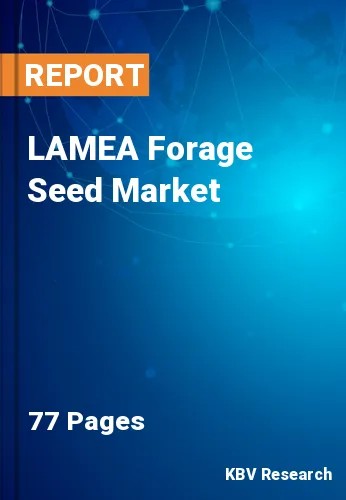
The Latin America, Middle East and Africa Forage Seed Market would witness Market growth of 10.0% CAGR during the forecast period (2022-2028).
Grazing livestock ingests forage, is a plant substance, which is grown from seeds found in pastures. Animals either graze the meadows on their own or are manually fed. The significant economic value of forages, together with their contribution to improving water quality, rotational advantages, habitat for wildlife, and a variety of ecosystem advantages, is predicted to drive the requirement for forage seeds around the world. Dairy farmers & farmers that produce forage for livestock feed companies are the primary users of forage seeds. These seeds are created based on the animal species that will be fed. The country's massive cattle, poultry, and other kinds of animal industries are the primary drivers of the Market .
When forage, particularly legumes, is intercropped with other crops, it can provide good quantity and quality of animal feed, increase soil nitrogen content, generate additional income for growers, and reduce soil damage, all of which are expected to increase demand for forage seed within the agriculture industry. Short-statured fodder crops like moth bean and cowpea can be grown in the interspaces of sugarcane, cotton, sorghum, and haze grain crops without impacting crop yields. Besides nitrogen fixation in the soil, forages indirectly assist the main crop. Moth bean, for example, helps to prevent root rot, whereas cowpea helps to combat spotted bollworms. Forage legumes will accomplish a dual purpose of improving rural community's livelihoods while also minimizing land degradation.
Because domestic production of forage seeds is limited, the country's strong demand for forage seeds is mostly met through imports. Some of the most common imported fodder seeds include Blue buffalo grass, Babala, Clover, Lucerne, and Kikyo. Oats, Cowpea, Sun Hemp, and Alfalfa are among the most often imported forage seed kinds, as per the South African National Seed Organization (SANSOR). When a comparison is made with other commercial feeds, an increase in the demand for the nutritional feed from livestock is largely met by natural forage, whose seeds are accessible at a low cost. This has boosted the need for forage seeds in the country even more.
Moreover, because of the growing number of ruminants, the cultivation of forage crops in the country is expanding, resulting in a higher demand for forage seeds. Rye, Bottlebrush, Blue Brush, Rhodes, Weeping love, Panicum, and Smut fingers are among the most widely grown grass crops in the country. The import of ryegrass in South Africa in 2019 is estimated to be roughly USD 6,820 thousand, according to the ITC Trade Map.
The Brazil Market dominated the LAMEA Forage Seed Market by Country 2021, and would continue to be a dominant Market till 2028; thereby, achieving a Market value of $617.6 million by 2028. The Argentina Market is poised to grow at a CAGR of 10.6% during (2022 - 2028). Additionally, The UAE Market would display a CAGR of 9.7% during (2022 - 2028).
Based on Species, the Market is segmented into Legumes and Grasses. Based on Product, the Market is segmented into Alfalfa, Clover, Ryegrass, Chicory, and Others. Based on Livestock, the Market is segmented into Poultry, and Cattle, and Others. Based on countries, the Market is segmented into Brazil, Argentina, UAE, Saudi Arabia, South Africa, Nigeria, and Rest of LAMEA.
Free Valuable Insights: The Global Forage Seed Market is Predict to reach $35.4 Billion by 2028, at a CAGR of 6.9%
The Market research report covers the analysis of key stake holders of the Market . Key companies profiled in the report include BASF SE, Land O'Lakes, Inc., Central Garden & Pet Company, Corteva, Inc. (Dow AgroSciences LLC), United Phosphorus Ltd. (Advanta Seeds), The Royal Barenbrug Group, Ampac Seed Company, Allied Seed, L.L.C., Hancock Farm & Seed Co., and BrettYoung Seeds Limited.
By Species
By Product
By Livestock
By Country
Our team of dedicated experts can provide you with attractive expansion opportunities for your business.
